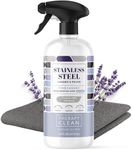Buying Guide for the Best Stainless Steel Cleaners
Choosing the right stainless-steel cleaner is essential to maintain the appearance and longevity of your stainless-steel appliances and surfaces. Stainless steel is known for its durability and resistance to corrosion, but it can still accumulate fingerprints, smudges, and stains over time. The right cleaner will help you keep your stainless steel looking pristine without causing damage. Here are some key specifications to consider when selecting a stainless-steel cleaner, along with explanations to help you make the best choice for your needs.FormulationThe formulation of a stainless-steel cleaner refers to its chemical composition. This is important because different formulations can have varying effects on the surface. Some cleaners are designed to remove tough stains and grease, while others are more suited for everyday cleaning and maintenance. Generally, formulations can be segmented into sprays, wipes, and creams. Sprays are convenient for quick applications, wipes are great for on-the-go cleaning, and creams can provide a more thorough polish. Choose a formulation based on how frequently you clean and the type of stains you typically encounter.
Residue-FreeA residue-free cleaner ensures that no streaks or films are left behind after cleaning. This is important for maintaining the aesthetic appeal of your stainless-steel surfaces. Cleaners that leave residue can attract more dirt and fingerprints, making the surface look dull. Look for products that specifically mention 'streak-free' or 'residue-free' on the label. If you prefer a high-gloss finish, ensure the cleaner provides that without leaving any unwanted residue.
ScentThe scent of a stainless-steel cleaner can enhance or detract from your cleaning experience. While some people prefer unscented cleaners to avoid any lingering smells, others might enjoy a fresh or citrus scent that leaves the kitchen smelling clean. Consider your sensitivity to fragrances and whether you prefer a scented or unscented product. If you have allergies or sensitivities, an unscented or hypoallergenic cleaner might be the best choice.
Ease of UseEase of use refers to how simple and convenient the cleaner is to apply and wipe off. This is important because a cleaner that is difficult to use can make the cleaning process more time-consuming and less effective. Products that come with easy-to-use spray nozzles, pre-moistened wipes, or simple application instructions can save you time and effort. Consider how much time you want to spend cleaning and choose a product that aligns with your preferences.
SafetySafety is a crucial factor, especially if you have children or pets. Some stainless-steel cleaners contain harsh chemicals that can be harmful if ingested or if they come into contact with skin. Look for cleaners that are labeled as non-toxic, biodegradable, or safe for use around food preparation areas. If safety is a top priority, opt for eco-friendly or natural cleaners that use plant-based ingredients.
CompatibilityCompatibility refers to whether the cleaner is suitable for all types of stainless-steel surfaces. Some cleaners are designed specifically for certain finishes, such as brushed or polished stainless steel. Using the wrong cleaner can damage the surface or leave it looking uneven. Check the product label to ensure it is compatible with your specific type of stainless steel. If you have a variety of stainless-steel finishes in your home, a versatile cleaner that works on all types might be the best option.

















